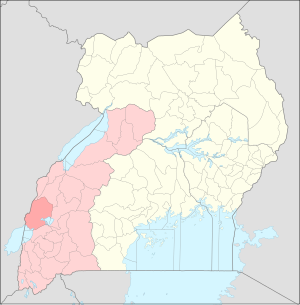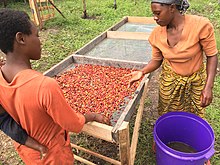Kasese district
| map | |
|---|---|
 Location of Kasese |
|
| Basic data | |
| Capital | Kasese |
| Geographical center | 0 ° 7 ′ N , 30 ° 1 ′ E |
| North South expansion | 70 km |
| East-west expansion | 64 km |
| surface | 2,724 km² |
| population | 532,993 (as of 2002) |
| Population density | 195.7 inhabitants / km² |
| The highest point | Margherita 5109 m |
| Time zone | UTC +3 |
| ISO 3166-2 | UG-406 |
Kasese is a district ( district ) in the southwest Uganda with 532,993 inhabitants. Like almost all districts of Uganda , it is named after its capital. The district is divided into two counties , 19 sub-counties and two town councils .
economy
The most important industry in the Kasese district is agriculture, from which over 85% of the population live. The average annual rainfall of only 348.24 mm measured in the years 2000–2009 classifies the Kasese district as a tropical dry zone in which agriculture can only be successfully carried out with the help of sophisticated irrigation methods. In the years 1993–1999 this was a hopeless undertaking with an average of 169.32 mm of rain per year. The period 1973–1979, summarizing the years 1978/1979, was similarly dry with an annual 198.38 millimeters.
geography
The landscape of Kasese is shaped by the Ruwenzori Mountains . With Mount Stanley / Margherita Peak lies the third highest point in Africa . Kasese lies on the equator and covers an area of 2,724 km², of which 885 km² belong to the Queen Elizabeth National Park and 652 km² to the Ruwenzori Mountains National Park . The district has a share in Eduardsee and Georgsee and borders in the west on the Democratic Republic of the Congo .
There are theoretically two unreliable rainy seasons, March to May and August to November. However, there has never been more than four rainy days with a double-digit millimeter amount per month. The previous record since weather records began in 1973 was March 1, 2001 with 89.92 mm of precipitation and only 52% humidity, closely followed by May 16, 1977 with 70.1 liters per square meter. The daily temperatures are on average between 19.4 and 32 ° C, but this can include extreme values of 10 ° C in the lower range and up to 36.1 ° C in the upper range. The calculated average temperature for the period 2000–2009 is 24.8 ° C after 24.3 ° C for the years 1973–1978. The extreme values for air humidity are 25% (measured on February 17, 1975) and 98% (measured on January 15, 2008).
As an equatorial district, Kasese surprises with the force of its gusts of wind, which reached 81.7 km / h as early as the 1970s. In 2002, new regional records were set here in August and November with 94.3 km / h and 92.4 km / h. The average wind speeds in the 1970s were still 2–10 km / h per month, the decade 2000–2009 already brought it to 5–12 km / h.
The Kasese district is the scene of intensive reforestation efforts to counteract the general desertification caused by the militarily motivated deforestation in the past. However, the fatal effects of the civilian need for firewood must also be pointed out here, as most households in the district still cook over an open fire.
